Gaza’s Bottle Rockets: Why Hamas’ Arsenal Wasn’t Worth a War
Aug 3 2014 / 8:05 pm
By Mark Perry.
Foreign Affairs – Hamas’ rocket fire into Israel has occasionally been described by the international press in dire terms — as a “non-stop onslaught,” an “unbearable” and “incessant” assault that is “paralyzing the country” and making life “intolerable” for ordinary Israelis. One CNN report even claimed that Israeli soldiers were collapsing from the psychological trauma of the explosions. It has made for a nasty portrait of Hamas and its military strategy, one that could even be read as a tacit endorsement of Israel’s stated goal of disarming the group with military force.
But a closer examination of Hamas’ military capabilities and goals reveals a very different picture. Most of Hamas’ arsenal is comprised of homemade rockets that are decidedly incapable of inflicting mass civilian casualties, flattening apartment blocks, or causing conflagrations that consume entire cities. “Hamas’ rockets can kill people and they have,” a counter-intelligence veteran of the U.S. CIA who spent his career monitoring Israeli and Palestinian military capabilities told me recently, “but compared to what the Israelis are using, the Palestinians are firing bottle rockets.” Far from justifying the ground campaign in Gaza, the nature of Hamas’ arsenal makes Israel’s ongoing military operation entirely counterproductive.
At the outset of the current conflict, according to Israeli Defense Forces (IDF), Hamas had 6,000 rockets deployed in Gaza, with an additional 5,000 deployed by its affiliate organizations, Islamic Jihad and the Palestinian Resistance Committees. Their combined arsenal is comprised of four rocket types: the short-range Qassam rocket with a range of 17.7 km (11 miles); the Grad rocket with a range of 48 km (30 miles); the M-75 with a range of 75 km (46 miles); and the M-302 with a range of 160 km (99 miles). The M-302 is by far the most sophisticated rocket in the arsenal, capable of reaching Haifa, which is 90 miles from Gaza City.
But even though Gaza has thousands of rockets, a large number of which can reach central Israel, Hamas’ arsenal poses only a negligible threat to Israel’s population. The vast majority of Hamas’ rockets are unsophisticated Qassam types that are manufactured in Gaza in primitive metal workshops filled with lathes and simple tools. Although these rockets are capable of carrying a warhead weighing 10–20 kg (22–44 pounds), they have no guidance system and contain only a modest propulsion unit.
The IDF was clearly surprised by the reach of the M-302, one of which landed near the city of Hadera (about 100 miles north of Gaza) just prior to the onset of Israel’s mid-July ground invasion. But Israel’s response should have been tempered by the simplicity of the rocket’s design. It had no guidance mechanism, its propulsion unit was modest, and it had a warhead much less lethal than the 175 kg (385 pounds) one it was designed to carry. Hamas, for its part, is very aware of these limitations. “We make up in numbers what we lack in quality,” a Hamas official told me several weeks ago. “We know what we’re doing. We can defend ourselves.”
The IDF has carefully and publicly catalogued Hamas’ rocket arsenal and its geographic reach, but has rarely offered a detailed analysis of Hamas’ rocket firepower. For instance, during Israel’s 2012 military operation in Gaza (known as Operation Pillar of Defense), the IDF publicized Hamas’ acquisition of the Iranian Fajr-5 rocket, a sophisticated Iranian surface-to-surface system capable of reaching central Israel. What the IDF failed to note, however, was that the reason only a small number of Israeli civilians were killed in the conflict (five in all) was that Hamas’ Fajr-5 guidance system was crude, at best, and its warhead nearly non-existent. In fact, according to the Hamas official with whom I spoke at the outset of the current conflict, Iran didn’t give full-fledged Fajr-5s to the militant group, it only transferred the technology to manufacture them, a claim confirmed at the time by an Iranian military official.
The IDF’s selective description of Hamas’ arsenal continued throughout Operation Pillar of Defense, although for those paying attention, it was obvious that the rockets fired from Gaza were relatively unsophisticated and not very powerful. In November 2012, Gaza’s al-Qassam Brigades announced that it had launched a Fajr-5 at Tel Aviv “as a response for the ongoing aggression against the Palestinian people,” but the rocket did not reach its target. Several days later, a Fajr-5 hit an apartment block in Rishon LeZion, which is Israel’s fourth-largest city located just south of Tel Aviv, destroying the top floor of an apartment complex and injuring two. If the Hamas rocket had carried a full payload, it is likely the entire apartment complex it hit would have been destroyed.
Hamas’ arsenal is considerably weaker today than it was in 2012. The overthrow of Egyptian President Mohammad Morsi in July of last year has constrained Hamas’ military capabilities. This is because it is no longer able to access large numbers of more lethal rockets as the new Egyptian government views Hamas as an extension of Egypt’s Muslim Brotherhood, whose leaders the new military regime has jailed. Hamas has managed to smuggle some BM-21 Grad rockets into Gaza from Libya, according to Hamas officials. The BM-21 was originally designed by the Soviet Union for use on combat vehicles and was subsequently modified by the Iranian government so that it could function as a stand-alone weapon. According to Israeli reports, Iran arranged the delivery of this rocket to Hamas (prior to the latter’s break with the Iranian-allied Syrian government) by breaking the rockets into four parts to ease their shipment to Egypt and then through the tunnels connecting Egypt with Gaza.
But Hamas has only managed to acquire a very small number of the BM-21 Grads. Prior to the Israeli ground operations in Gaza, it had no more than 200. Worse yet, the rockets have proven to be of limited use: Standing more than 20 feet tall, they are exceedingly difficult to maneuver and operate. They are also incredibly vulnerable. In the first few hours of the 2012 war between Israel and Gaza, 75 percent of Hamas’ Fajr-5 and Grad rocket capacity was destroyed by the Israeli Air Force, according to a Hamas official with whom I spoke at the time.
Hamas’ rockets have also proven vulnerable in the current Israeli offensive, in which the Israeli government claims to have destroyed 4,000 military targets in Gaza, which include Hamas’ troop concentrations, command and control centers, and rocket launch sites. If prior Israeli military operations are any indication, the IDF would have had sufficient intelligence and firepower to eliminate two-thirds of Hamas’ rocket capacity in the first 48 hours of its current air offensive. It’s true that Hamas has nonetheless managed to continue its barrage of rocket fire on Israel. But the group is under few illusions that it is capable of inflicting any material harm. Instead, its aim has been to cause psychological damage and force Israel to negotiate by discrediting its military strategy, both domestically and internationally.
Although Hamas’ rockets are of limited military use against Israel, Israel has allowed the rocket fire to rashly affect its strategic calculations. Israel has now focused its military campaign on the tunnels that allow Hamas to hide its rockets from Israeli surveillance aircraft, which include drones, helicopters, and F-16 jets. In public, the Israeli government has focused on how Hamas might use the tunnels to attack its citizens within Israel, but the IDF is very aware that the tunnels directly affect Hamas’ rocket capabilities.
But the IDF seems not to have understood that, in training and deploying its rocket battalions, Hamas has modeled its strategy on other liberation movements. In November 1965, the United States’ 1st Cavalry Division faced off against a number of North Vietnamese regiments in the Ia Drang Valley, in western Vietnam. What was important about the Ia Drang battle was that the Vietnamese had purposely lured U.S. units into a close-quarters fight, where the Americans could not use their artillery or helicopter-mounted missile systems. As one Vietnamese commander saidin a meeting with a U.S. military commander after the war, the North Vietnamese tactic was to “grab you by your belt buckle.”
Palestinians used these same tactics during the second intifada in April 2002, when militants battled the IDF in the streets of the West Bank city of Jenin. The Jenin battleground was a close-quarters fight in which the Israeli advantage in firepower was negated by having to fight house-to-house and street-to-street. Twenty-three IDF soldiers were killed, along with 54 Palestinians. The Palestinian Authority’s president at that time, Yasser Arafat, extolled the Jenin fight as a victory, comparable in importance to Stalingrad. “It is Jeningrad,” he said.
The Jenin model has had a powerful impact on the way the Palestinians have fought subsequent wars, including in Gaza. This time, Hamas’ rockets are the lure. To stop the rockets (and unearth Hamas’ tunnels), the IDF has been forced to fight in the streets and warrens of Gaza City and Palestinian refugee camps, thereby negating Israel’s huge firepower advantage and leading to increased Israeli military casualties. In that sense, although Hamas’ rockets haven’t taken large numbers of Israeli lives, they’ve called into question the IDF’s ability to defend the Israeli populace, choked off the country’s most important international airport, and helped level the military playing field. But all of that has only been possible because the Israeli government has overreacted to what has always been a minor material threat.
Few in Israel or the West seem to understand the purpose of Hamas’ rocket attacks. Killing Israelis is a secondary goal in launching the rockets. The primary goal is to change Israel’s political calculations by creating the conditions for that country’s international isolation. And for now, at least, it seems to be working.

